A New Era of Intelligence
What if your technology didn’t just follow instructions, but actually learned from experience and improved on its own? That’s the power of AI. Once a futuristic concept, AI is now driving real-world results across industries by solving problems faster, predicting outcomes with precision, and uncovering insights that were previously out of reach.
What Is AI?
AI refers to systems built to perform tasks that normally require human intelligence, such as learning, decision-making, and language processing. Unlike traditional software that follows static rules, AI systems analyze data and evolve over time, improving their performance as they go.
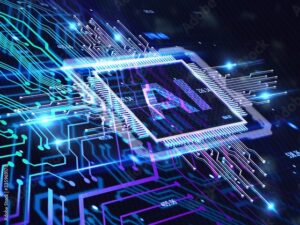 Two Primary Types of AI
Two Primary Types of AI
AI doesn’t come in just one form. It generally falls into two categories, based on scope and capability:
- Narrow AI – Specialized systems trained to perform specific tasks, like virtual assistants and chatbots. Most AI in use today falls into this category.
- General AI – A form of AI that mimics human intelligence across a wide range of activities. While still in development, it’s the long-term goal for many researchers.
AI vs. Traditional Automation
Traditional automation executes pre-defined, rule-based tasks. It’s reliable but rigid. AI-powered automation, on the other hand, adapts. It learns from data inputs, recognizes patterns, and makes intelligent decisions—turning static processes into dynamic, optimized systems.
AI Across Industries
From fraud detection in finance to diagnostic tools in healthcare, AI is revolutionizing how work gets done. In retail, it delivers customer insights and personalized shopping experiences. In cybersecurity, it detects threats in real time. Its economic impact is massive: by 2030, AI is projected to contribute $15.7 trillion to the global economy.
What This Guide Covers
This page will explore how AI is transforming business today—and where it’s heading next. It will cover:
- Key benefits of AI across core business functions
- Use cases in industries like healthcare, finance, and retail
- AI technologies including machine learning, NLP, and generative AI
- Emerging trends, adoption strategies, and long-term implications
Whether you’re new to AI or ready to take it further, this guide will help you figure out what’s next—and how to get there.
The Evolving Role of AI in Business Strategy
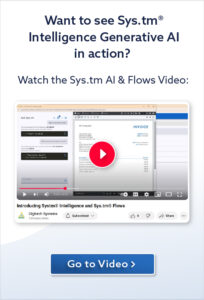
It also redefines how organizations create value. Instead of reacting to shifts in the market, businesses can anticipate trends and position themselves ahead of the curve. AI supports scenario testing, outcome evaluation, and prioritization of the most promising strategies, without the delays of traditional reporting cycles. These capabilities are leveling the playing field, allowing businesses of all sizes to operate with the agility once reserved for enterprise giants.
 AI as an Enabler of Business Intelligence
AI as an Enabler of Business Intelligence
Data has always played a central role in strategy. However, the scale and complexity of today’s information demand a more advanced approach. AI turns raw inputs into clear, actionable insights. It draws from internal operations, customer interactions, and external forces, highlighting what matters most. This gives decision-makers a sharper view of risks, opportunities, and forecasts.
Instead of static dashboards or delayed reports, businesses now receive instant recommendations powered by AI. From adjusting pricing in response to demand shifts to reallocating resources for maximum impact, AI strengthens the precision and pace of strategic decisions.
From Rule-Based Automation to Learning Systems
Traditional automation is ideal for predictable, repetitive processes. It follows fixed rules, which is great for tasks like data entry or invoice routing. However, when decisions depend on variables like context or behavior, static systems come up short. Their functionality ends where adaptability begins.
That’s where AI changes the game. Unlike static systems, AI-powered tools refine their responses over time based on new data. For example, an AI-powered scheduling tool can recognize trends in past coverage to recommend better shift planning. A customer service bot can deliver smarter responses with each conversation. The result is a more intelligent workflow that reflects actual conditions.
Real-Time Decision Intelligence
AI gives businesses a strategic edge in fast-moving, high-stakes environments. Rather than simply reporting on the past, it anticipates what’s next and guides decisions in the moment.
- Finance: AI monitors transactions live, identifying fraudulent patterns before they become costly issues.
- Logistics: Smart routing tools adjust schedules based on traffic, weather, and supply chain updates, reducing delays and operational waste.
- Healthcare: Diagnostic systems catch early signs of disease in patient data, enabling faster, more accurate interventions.
These real-time capabilities sharpen execution, reduce risk, and keep organizations ahead, even in unpredictable conditions.
Understanding the AI Landscape
The Big Picture
AI adoption is accelerating—not just because of what it can do, but because of what businesses are up against. Labor shortages, market volatility, and increasing pressure to move faster and operate smarter have made AI more than a nice-to-have.
Here’s how it fits into larger business needs:
Fewer People, Same Expectations
Industries like manufacturing, healthcare, and logistics are navigating workforce shortages. AI-powered robotics and task automation help fill critical gaps by handling repetitive or physically demanding jobs. In warehouses, for example, autonomous systems now manage picking, packing, and sorting—boosting throughput without adding headcount.
Market Volatility and Uncertainty
From global supply chain disruptions to shifting consumer behavior, organizations face near-constant change. AI provides a way to adapt in real time. Predictive analytics flag emerging trends before they hit performance metrics, while dynamic modeling helps teams adjust operations and strategies without waiting on quarterly data.
Rising Cost Pressures
Organizations are under pressure to reduce costs without compromising output or customer experience. AI helps by identifying inefficiencies, automating high-volume manual processes, and recommending smarter resource allocations. In sectors like retail, AI-powered pricing tools and demand forecasting drive profitability without increasing spend.
The Need for Smarter Decision-Making
Leaders can’t rely on gut instinct when decisions affect thousands of customers or millions in revenue. AI synthesizes data from across the business to highlight risks, surface trends, and guide next steps with greater accuracy.
Types of AI in Business
AI comes in many forms, each designed to solve specific business challenges. Some tools specialize in analyzing data and making predictions. Others generate new content, interpret images, or interact through language. Understanding these categories, and their applications, helps businesses choose the right solutions to expand value.
 Machine Learning (ML)
Machine Learning (ML)
Machine learning is one of the most widely used types of AI in business. These systems learn from historical data. By consuming large data sets, ML recognizes patterns and categories in the information and uses them to make predictions or decisions without being explicitly programmed.
- Predictive Analytics: Businesses use ML to forecast trends in everything from inventory and revenue to customer churn and equipment maintenance. It helps teams plan more accurately, avoid disruptions, and act ahead of demand shifts.
- Fraud Detection: Financial institutions and e-commerce platforms rely on ML models to spot unusual behavior in real time, flagging suspicious transactions before they result in financial loss.
- Recommendation Systems: ML powers the algorithms behind personalized product suggestions, movie picks, and content feeds on platforms like Amazon, Netflix, and Spotify—boosting user engagement and revenue.
Natural Language Processing (NLP)
NLP allows machines to understand, interpret, and generate human language. It’s especially powerful in customer-facing applications and content-heavy workflows.
- Chatbots and Virtual Assistants: These tools handle common customer questions, schedule appointments, and guide users through processes. By automating routine interactions, they reduce wait times and free up human agents for more complex tasks.
- Sentiment Analysis: NLP scans reviews, social media, and feedback forms to detect how customers feel about products, services, or experiences. These insights help businesses fine-tune messaging, improve service, and spot issues early.
- Transcription and Translation: Automated tools convert speech to text for meeting notes and generate subtitles for video content. They also enable real-time translations, making global collaboration and customer communication more seamless.
Computer Vision
Computer vision enables machines to “see” and interpret visual data. It’s widely used in industries that rely on imaging, visual inspection, or real-world navigation.
- Facial Recognition: This technology is used for secure logins, biometric verification, and customer identification in retail. It enhances both protection and convenience by recognizing individuals through visual data.
- Self-Driving Vehicles: Autonomous vehicles rely on computer vision to detect obstacles, interpret traffic signals, and navigate complex environments. These systems process visual input in real time to enable safe and efficient driving.
- Medical Imaging: AI analyzes medical scans like X-rays and MRIs to spot anomalies that might be missed by the human eye. This speeds up diagnoses and improves accuracy in patient care.
- Quality Control: In manufacturing, computer vision inspects products on the production line to detect defects or inconsistencies. This ensures high product quality and reduces the risk of costly recalls.
Generative AI
Generative AI is a fast-growing category that creates new content based on learned patterns and inputs. These tools go beyond analysis—they generate copy, code, visuals, and more.
- Text and Content Creation: Tools like ChatGPT generate marketing copy, blog posts, reports, and summaries. They reduce the time and effort needed to produce high-quality content at scale.
- Image and Video Generation: Systems like DALL·E create custom visuals for ads, social media, and product mockups. They enable faster creative output without the need for manual design work.
- Music and Code Generation: AI can now compose original music and generate code snippets to support developers. This accelerates both creative and technical workflows while reducing production bottlenecks.
 AI vs. Process Automation
AI vs. Process Automation
While AI and traditional process automation are often discussed together, they serve distinct purposes. Automation focuses on executing defined tasks quickly and consistently. AI, on the other hand, brings adaptability—analyzing data, learning patterns, and making real-time decisions. Knowing how and when to apply each—individually or in tandem—can dramatically improve both efficiency and agility.
Adaptive Decision-Making
AI systems excel at continuous learning, enabling them to adapt to changing data and conditions without manual input. This makes them ideal for environments where speed and variability matter. In supply chain operations, for example, AI can anticipate demand shifts and adjust inventory or reroute shipments proactively. AI forecasting reduces errors significantly, minimizing stockouts and improving turnover. This adaptability helps businesses stay ahead of disruption rather than reacting to it.
Dynamic Workflow Optimization
Unlike traditional automation, which handles fixed tasks, AI excels in multivariable workflows that adapt based on context or behavior. It can coordinate thousands of variables in real time to optimize complex operations. In marketing, AI personalizes campaigns based on user actions. In maintenance, predictive models flag issues early—reducing breakdowns by 70% and maintenance costs by 25%. These capabilities make AI a game-changer in dynamic, data-rich business environments.
When to Use AI vs. Rule-Based Automation
The right tool depends on the complexity of the task and how often conditions change.
- Traditional Automation: This is better for structured, rule-based processes with clear inputs and expected outputs. These are tasks like invoice approvals, payroll, report generation, or data syncing—where consistency, speed, and accuracy are essential, and the steps rarely change. It’s efficient, reliable, and ideal for scaling repetitive work.
- AI: This is better for tasks that require context, judgment, or adaptation. That includes fraud detection, lead scoring, product recommendations, or real-time customer support—situations where success depends on recognizing patterns, learning from new data, and adjusting outputs as conditions evolve.
Why the Best Approach is Often Hybrid
Many leading organizations are now combining AI and automation to get the best of both worlds. Rule-based systems establish dependable baselines, while AI introduces adaptability and insight. For example, a financial services chatbot might use automation to answer balance inquiries but apply AI to detect tone and escalate frustrated users to human agents. This layered approach improves user experience, reduces resolution time, and optimizes staffing across functions.
Blending AI with process automation helps organizations scale intelligently. With the right balance, businesses can respond faster, operate leaner, and adapt to change without losing control or consistency.
Strategic Areas for Implementation: How AI is Changing Core Business Functions
AI no longer stops at back-office automation; it has become central to how businesses operate across departments. That equates to smarter decisions, faster reactions to change, and deeper insights at scale. From financial forecasting to customer engagement, AI is being embedded directly into business workflows to improve accuracy, responsiveness, and performance.
 Decision Intelligence
Decision Intelligence
Modern organizations are flooded with data—but data alone doesn’t drive value. AI helps convert that data into decisions by identifying patterns, forecasting outcomes, and highlighting the best course of action. Whether adjusting a marketing campaign mid-flight or reallocating resources in real time, AI is helping teams act with speed and precision, especially in areas like finance, logistics, and customer strategy.
Finance
AI is diversifying financial strategy by supporting real-time decision-making in trading, credit, and risk analysis. From algorithmic trading that reacts instantly to market shifts, to AI-driven credit scoring that evaluates nontraditional data points like spending behavior or digital footprint, finance teams are using AI to spot patterns humans might miss. It also enhances risk modeling, helping institutions simulate complex scenarios and adjust positions proactively, which improves resilience in volatile markets.
Logistics
AI is streamlining logistics by turning reactive processes into predictive ones. Machine learning models analyze real-time data—like weather, traffic, and warehouse capacity—to optimize delivery routes and reduce delays. AI also forecasts demand with greater accuracy, helping teams adjust inventory levels and avoid stockouts or overordering. In complex supply chains, AI improves end-to-end visibility, surfacing bottlenecks before they escalate and enabling faster, more coordinated responses across suppliers, distributors, and fulfillment centers.
Marketing
AI is transforming marketing from broad campaigns to finely tuned, data-driven strategies. By analyzing user behavior, purchase history, and engagement patterns, AI enables more precise customer segmentation and personalization at scale. Marketers can tailor content, offers, and timing based on real-time insights—leading to higher engagement and improved ROI. AI also supports dynamic pricing, budget optimization, and multichannel attribution, helping teams make smarter decisions about where and how to invest.
AI-Powered Customer Experiences
Beyond operations and analytics, AI is also enhancing how businesses interact with their customers. From curated product suggestions to dynamic advertising, these tools make every touchpoint smarter and more relevant.
Hyper-Personalized Marketing
AI enables personalization that goes far beyond using a customer’s name in an email. It dynamically adjusts messages, product recommendations, and promotions based on real-time behavior, past purchases, browsing activity, and even external data like weather or location. This allows brands to meet customers with the right message on the right channel at the right moment—without manual input. Research shows that enhancing the customer experience through personalization can lead to a 20% increase in customer satisfaction.
Recommendation Engines
AI-powered recommendation engines personalize a shopping or viewing experience by analyzing user behavior in real time. These systems go beyond simple “people also bought” logic—factoring in browsing patterns, purchase history, session timing, and contextual signals to serve up tailored suggestions. For retailers and content platforms, this level of precision increases average order value, boosts engagement, and keeps users coming back. It’s a proven driver of loyalty and conversion that makes digital experiences feel intuitive and relevant.
AI for Knowledge Work
In knowledge-intensive roles, AI is changing the way professionals think and create. It complements, rather than replaces expertise—accelerating research, organizing information, and handling repetitive tasks. This allows individuals to concentrate on complex problem-solving.
Demand Forecasting and Logistics
AI improves demand forecasting by analyzing sales data, seasonal patterns, and external signals like economic trends or weather. This enables businesses to plan more accurately, which reduces excess inventory while avoiding stockouts. In logistics, AI enhances efficiency through smarter routing and dynamic warehouse coordination. These systems automate decisions that traditionally relied on manual input, cutting delays and operational waste. The result is faster fulfillment, better resource use, and greater resilience across the supply chain.
Content Creation for Marketing and Sales
AI tools help marketing and sales teams move faster without compromising quality. They can generate headlines, draft emails, suggest content themes, or build visual assets—all in less time than it takes to start from scratch. AI tools don’t replace creativity, but they give teams a stronger starting point. By reducing manual work and keeping content aligned with brand voice, AI lets professionals focus on strategy and targeting, which improves campaign execution.
 AI in Supply Chain & Operations
AI in Supply Chain & Operations
AI enhances supply chain efficiency by providing predictive insights and automating complex processes. It aids teams in anticipating delays, reducing unnecessary costs, and making informed decisions promptly.
Predictive Inventory and Logistics
AI analyzes historical sales and market data to anticipate inventory needs. This helps avoid overstock and stockouts while optimizing warehouse space to reduce carrying costs. In logistics, AI tracks variables like weather, traffic, and supplier delays to improve delivery processes. These systems can reroute shipments or adjust priorities automatically, preventing disruptions. AI-enabled forecasting can reduce supply chain errors by up to 50%, enhancing both reliability and customer satisfaction.
Intelligent Supplier Management
AI improves supplier relationships by surfacing risks and performance gaps early. It evaluates factors like delivery reliability, pricing changes, and compliance issues—flagging vendors that may cause disruptions. AI also monitors external threats, such as geopolitical instability or shortages in raw materials, giving procurement teams time to act. With this level of intelligence, businesses can diversify supply sources, negotiate better terms, and reduce reliance on vulnerable vendors. The result is a supply chain that’s both lean and resilient.
Core Industries
Healthcare
AI supports healthcare by detecting disease earlier, personalizing treatments, and improving surgical precision. Imaging tools powered by deep learning can catch signs of cancer or eye disease as accurately as trained specialists. AI also analyzes medical histories, including genetic profiles, to inform treatment plans. In the operating room, robotic systems guided by AI enhance precision—which reduces recovery times. These technologies improve outcomes, reduce complications, and create new possibilities for preventive and personalized medicine.
Education
AI enables adaptive learning platforms that customize content to student needs. These systems respond to each learner’s pace and performance, helping them master material more effectively. Automated grading tools provide instant feedback, freeing teachers to focus on support and enrichment. While the benefits are clear, the rise of AI in classrooms also raises concerns about data privacy and equity as well as student performance. Educators must balance innovation with transparency, fairness, and responsible use of AI tools by learners.
Retail and Small Businesses (SMBs)
Small and midsize businesses are using AI to improve operations, compete more effectively, and deliver stronger customer experiences. Tools for forecasting help manage inventory more efficiently, while chatbots handle support around the clock. Marketing platforms powered by AI allow businesses to target customers more precisely, personalize offers, and analyze campaign performance. By automating repetitive tasks and extracting insights from data, AI helps SMBs scale smartly—boosting revenue and freeing up time for owners to focus on growth.
The Future of AI: Trends to Watch
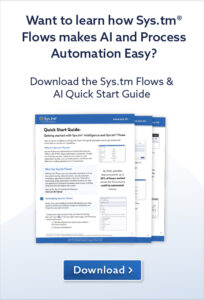
Trend one: Generative AI’s Expansion
Generative AI has significant promise in ideation, outlining, and writing content for materials-heavy occupations like marketing and software development.
Content and Marketing
Generative AI is changing how businesses create content at scale. Tools like ChatGPT and DALL·E help marketers quickly generate blog articles, social media posts, ad copy, and visuals. Teams can brainstorm ideas, draft messaging, and design assets in a fraction of the time it once took. Human creativity still leads, but AI lightens the workload by taking over repetitive or first-draft tasks. This gives marketers more time to focus on strategy, storytelling, and higher-level creative execution that drives impact.
Software Development
In software development, AI is improving workflows with coding assistants like GitHub Copilot. These tools help developers write code faster by suggesting completions, spotting bugs, and automating routine programming tasks. Rather than replacing programmers, AI serves as an accelerant—reducing manual effort and lowering the chance of simple errors. This helps teams deliver projects more efficiently and improve code quality. It also frees developers to focus on higher-value work like building system architecture or developing new features.
Trend two: Autonomous AI Agents
Autonomous agents, sometimes called Agentic AI, are AI systems that can make decisions and act independently to achieve specific goals. They monitor conditions, adapt to changes, and complete tasks without step-by-step instructions.
IT and Customer Support
Autonomous AI agents are beginning to handle more of the workload in IT and customer support. Virtual assistants can troubleshoot common tech problems, reset passwords, and guide users through basic system fixes. They escalate complex issues only when necessary, which eases the burden on human support teams. This shift leads to faster resolution times and a more consistent experience for users, while also helping businesses lower support costs.
HR and Recruitment
In Human Resources (HR), AI is helping to streamline recruiting and onboarding. Systems can now screen resumes, identify qualified candidates, and schedule interviews without human input. Some even initiate onboarding paperwork, saving time for HR teams. By automating these early steps, recruiters and hiring managers can focus more on building relationships, evaluating cultural fit, and planning for long-term workforce needs—ultimately strengthening both the candidate experience and employee retention.
Trend three: AI and Human Collaboration
Research consistently find that AI adds highest value to companies when it is paired with smart humans, what Harvard Business Review calls an “augmented workforce.”
Data-Driven Decision Making
AI is transforming how businesses make decisions by surfacing insights at a speed and scale humans alone cannot match. Tools that analyze large datasets can highlight patterns, forecast trends, and offer strategic recommendations in seconds. However, human expertise remains essential for interpreting these results, considering broader business impacts, and making final decisions. Companies that combine AI’s speed with human intuition and ethical judgment will be better positioned to innovate responsibly and deliver outcomes that align with both business goals and customer needs.
New Roles and Skillsets
As AI adoption grows, businesses are seeing a rise in new professional roles and the need for specialized skillsets. AI trainers help fine-tune models, prompt engineers craft better generative AI outputs, and ethical AI specialists ensure responsible use. These positions blend technical knowledge with strategic thinking and ethical awareness. Companies that prioritize upskilling their current teams—or recruit for these emerging roles—will gain a competitive edge, ensuring their AI systems are not only effective but aligned with long-term operational and ethical standards.
Trend four: Ethical AI and Regulation
The legal landscape for AI technologies is still evolving, so it’s wise to monitor emerging conversations and regulations to understand how they may impact your AI use.
Regulatory Compliance
New AI laws are reshaping how companies must operate. The European Union AI Act demands documentation and human oversight for high-risk systems, while US regulations focus on safety and civil rights protections. Companies can’t treat compliance as a checklist; they need flexible governance systems that evolve with technology. Strong internal standards will matter as much as legal ones, especially for businesses that want to build lasting trust with users in a more closely scrutinized digital environment.
Bias and Fairness
Unchecked AI can reinforce bias, especially when trained on flawed data. Companies must go beyond technical fixes by questioning where data comes from, how models make decisions, and who might be excluded. Auditing alone isn’t enough without clear accountability for outcomes. Building fair systems takes constant adjustment, not just one-time tests. Companies that prioritize transparency and inclusion early will be better positioned to avoid reputational damage and meet growing demands for ethical AI from regulators and users alike.
Trend five: AI in the Metaverse and Web3
For companies who leverage the metaverse, AI can deepen personalization and lead to worker confidence in open ecosystems.
Smart Contracts and DeFi
Decentralized finance (DeFi) is evolving fast, and AI is becoming essential for keeping systems secure and scalable. Smart contracts enhanced by AI can detect fraud patterns early and trigger automatic protections without human intervention. This speeds up response times and strengthens trust in platforms where traditional oversight doesn’t exist. As DeFi grows, companies that integrate AI thoughtfully will be better able to manage risk, build user confidence, and meet the higher expectations that come with operating in open financial ecosystems.
Personalized Digital Experiences
In the Metaverse, AI is driving real-time personalization to create deeper, more engaging user experiences. Systems now adjust virtual environments based on real-time behavior, creating more fluid, personalized interactions. Instead of static worlds, users can encounter environments that evolve as they move, shop, or play. Brands that use AI to shape these experiences without feeling invasive will have a clear advantage. Personalized design isn’t just about engagement—it’s about creating spaces that feel more human, even in fully digital environments.
Challenges and Considerations
 Data Privacy and Compliance
Data Privacy and Compliance
As AI systems manage more personal data, privacy is no longer a technical concern—it’s a business-critical issue. Regulations like GDPR and CCPA raise the bar, requiring companies to rethink how they collect, store, and use information. It’s not enough to encrypt files or mask identities; businesses must also give users meaningful control over their data. In working with generative AI tools, companies face new risks. Choosing platforms that respect source material and protect proprietary information is essential to avoid unintended exposure.
Managing Generative AI (GenAI) Risks
The legal environment around content created by generative AI remains unsettled. Companies must vet GenAI tools carefully to ensure outputs respect intellectual property rights and internal data remains secure. Some platforms allow businesses to block sensitive information from being crawled and reused, while others do not. Choosing the wrong tool could expose companies to data breaches or copyright disputes. A proactive approach to GenAI governance helps protect assets, maintain compliance, and reduce legal risks as regulations tighten.
Workforce Impact
AI is reshaping the workforce by automating repetitive tasks and creating demand for new skillsets. Businesses should invest in reskilling programs that prepare employees for AI-driven roles, focusing not just on technical knowledge but on adaptability and digital collaboration. Leaders will also need new management strategies. As human and digital workers collaborate more closely, managers will learn to measure hybrid team performance and maintain culture across increasingly complex organizational structures.
Adoption Barriers
Despite AI’s potential, many companies face significant adoption challenges. High upfront costs, integration difficulties, and a lack of internal expertise often stall progress. A smart strategy is to start small: launch targeted AI projects tied to clear business outcomes and expand gradually. Building early wins helps secure executive buy-in, train internal champions, and refine broader AI strategies. Strategic partnerships with experienced AI vendors can also ease implementation and strengthen long-term adoption efforts.
Finding ROI
AI investments need to drive measurable business outcomes to succeed. Proven applications—such as predictive analytics for supply chains, chatbots for customer service, and real-time fraud detection—consistently deliver strong returns. According to McKinsey’s 2025 State of AI report, the majority of companies that incorporate GenAI are still seeking significant bottom-line impact. To maximize return, companies can integrate AI into core processes to sharpen execution, improve decision-making, and boost overall agility, helping businesses scale intelligently and sustainably.
Real-World Examples of AI in Action
For many businesses, AI has become a daily tool—not just a buzzword. From speeding up research to helping teams make faster decisions, these real-world examples show how AI is already reshaping work in practical, measurable ways.
Sales Operations: Turning Monthly Reports into Strategic Reviews
At a consumer goods company, the sales operations team no longer spends days compiling data. They highlight a folder of monthly Excel reports and prompt their AI tool to generate a comprehensive annual summary. The system totals key metrics, identifies top-selling SKUs, flags underperforming regions, and charts monthly trends. Within minutes, leaders receive a polished report. It eliminates the need for manual spreadsheets and gives teams more time to focus on insights, strategy, and performance planning.
Legal and Compliance: Contract Analysis in Seconds
A healthcare provider streamlines vendor agreement management using AI. Instead of searching through dense contracts, staff ask questions like, “What’s the termination clause for the imaging vendor?” The AI scans legal documents and returns concise, referenced answers. It also flags expiration clauses and tracks auto-renewals, helping teams minimize legal exposure. This ensures no key detail is missed, strengthens compliance processes, and lets staff spend less time buried in documents—and more time serving patients and managing partners.
Marketing Teams: Faster Campaign Launches from Existing Assets
When a SaaS company shifts direction, its marketing team uses AI to quickly build campaigns. They upload blog posts, landing pages, and brand guidelines—then prompt the system to generate emails, social copy, and other marketing collateral. The output reflects brand tone and current messaging, serving as a first draft. Human editors refine and publish the assets in half the time. This process gives marketers a head start without sacrificing quality, and helps the team stay agile and focused.
 Document Summarization: Making Long Content Digestible
Document Summarization: Making Long Content Digestible
A consulting firm deploys AI to search its document archive. Employees now prompt the system with questions like, “What does the Q3 update say about budget?” or “Summarize the compliance section.” The AI finds relevant content, highlights key points, and returns short summaries with page references. This saves hours of manual reading, improves accuracy, and enhances collaboration. Whether onboarding new hires or answering client questions, teams gain faster access to the information they need to deliver results.
Client Services: Smarter Project Recall
At a creative agency, account managers revisit prior work using AI. Instead of digging through folders and old threads, they ask, “What did we present to the biotech client in 2022?” The system retrieves performance data and feedback. Teams use that context to build smarter proposals that reapply proven ideas. This reduces redundant work while improving client outcomes. Creative teams feel empowered, not burdened, because they work from a strong foundation instead of reinventing solutions each time.
HR and Onboarding: Reducing Ticket Volume
A fast-growing logistics company turns to AI to support HR. They feed the system policies and internal FAQs, then offer new hires a chat interface to ask questions like, “How do I submit expenses?” or “When does PTO reset?” AI gives instant answers, which reduces HR tickets and supports the workload. New employees onboard faster, feel more confident, and navigate systems independently. This builds a smoother experience while allowing HR teams to focus on strategy and employee growth.
Preparing for an AI-Powered Future: How Businesses Can Start with AI Today
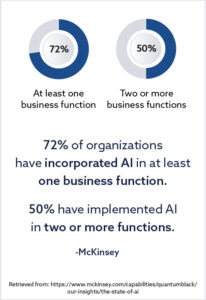
Identify High-Impact Use Cases
AI works best when it solves a clear problem. For many organizations, the right starting point is the one that makes daily work easier, especially in areas that are data-rich, repetitive, or resource-constrained.
- Customer Engagement – Tools like chatbots and recommendation engines are already transforming how companies interact with customers. These systems respond instantly to inquiries, tailoring suggestions based on behavior, and freeing up staff for more complex issues. When done well, they improve both speed and satisfaction without feeling robotic.
- Operational Efficiency – AI can automate routine tasks like data entry or inventory checks, detect fraud faster than manual reviews, and highlight inefficiencies across workflows. Even small wins—like automating a weekly report—can compound over time.
- Predictive Insights – Forecasting used to rely heavily on intuition and spreadsheets. Now, AI can spot trends early to help teams plan with more precision. Whether it’s predicting equipment failure or tracking sales momentum, this type of insight gives companies a strategic edge.
Build an AI-Ready Workforce
AI can’t deliver value if people don’t know how to use it. Teams need not only the tools but also the training to apply them confidently. That starts with making AI accessible across the organization.
- Upskilling and Reskilling – You don’t need every employee to become a data scientist. But you do need teams to be comfortable working with AI-powered tools. Training in areas like data literacy, automation basics, and prompt writing (for generative tools) can make a meaningful difference.
- Cross-Functional Knowledge – AI isn’t just an IT concern. Sales, marketing, HR, operations, and finance all benefit from smarter tools. Help each team understand where AI fits into their daily work—so they can lead, not lag, in adoption.
- Human-AI Collaboration – Employees shouldn’t feel like they’re being replaced. They should feel supported. That means positioning AI as a partner in decision-making, not the final word. The best outcomes come when human judgment and machine intelligence work together.
Choose Tools That Align with Business Goals
It’s easy to get distracted by buzzwords and big promises. But the most successful AI projects start with a clear question: what are we trying to achieve?
- Efficiency vs. Innovation – Are you looking to cut down manual processes, or are you exploring new ways to grow? Some AI tools do one, some do the other. Knowing your goal helps you avoid chasing features that don’t serve your strategy.
- Scalability Matters – Especially for small or growing teams, tools that scale make implementation smoother. Cloud-based platforms often offer flexibility without heavy IT investment, making them a smart choice for early adopters, and microservices platforms (like our own Sys.tm) offer usage-based billing, so you can exactly match the cost to use.
- Compliance and Ethics – Privacy laws like GDPR and CCPA aren’t optional. Choose solutions that help you meet legal requirements and uphold your values, especially if you’re handling sensitive data. Responsible AI use isn’t just safer; it builds trust.
Long-Term Strategic Considerations
AI isn’t just a short-term efficiency tool—it’s reshaping how entire industries operate. As adoption grows, businesses that think strategically about where AI adds value—and where human judgment still leads—will be best positioned to thrive.
How AI Will Shape Key Industries
While nearly every sector stands to benefit from AI, its most transformative impact is already surfacing in a few critical areas:
- Healthcare – From diagnostic tools that detect illness earlier to robotic-assisted surgeries and tailored treatment plans, AI is making medicine more precise and proactive. These advances not only improve outcomes but also free up clinicians to focus on personalized care.
- Finance – AI is enhancing security and speed in high-stakes environments. It powers fraud detection, automates regulatory reporting, and drives algorithmic trading. This gives institutions a sharper edge and reduces risk across the board.
- Supply Chain and Logistics – In a field defined by complexity, AI helps simplify decisions. It forecasts demand more accurately, which helps with coordinating inventory needs and optimizing delivery schedules based on live data. The result is a supply chain that’s leaner, faster, and more resilient.
- Creative Industries – Marketers and content creators are using AI to work faster without compromising originality. From generating first-draft visuals to optimizing ad copy, AI handles time-consuming tasks. This leaves space for human creativity to lead the process.
Balancing AI and Human Expertise
As AI becomes more embedded in business processes, it’s important to stay grounded in what machines can and can’t do. Success lies in using AI to extend—not replace—human intelligence.
- AI as a Support Tool – AI is incredibly effective at spotting patterns and processing large datasets quickly. But it still relies on humans to provide context and make ethical calls. As a result, it serves as an accelerator, not a decision-maker.
- Ethical AI Use – With power comes responsibility. Businesses need clear frameworks to monitor bias, ensure transparency, and meet evolving regulations. Governance shouldn’t be a one-time check; it should be an ongoing process rooted in company values.
- Creativity and Emotional Intelligence – AI can’t build relationships or drive culture. These are uniquely human strengths. While AI handles the repetitive tasks, teams should focus on what they do best: thinking critically, connecting meaningfully, and making the kind of decisions no algorithm can.
Turning Insight into Action
Artificial intelligence is changing how business gets done. What started as an emerging technology has become a practical tool across every sector, helping teams make decisions faster, understand patterns in real time, and reduce friction in both customer and internal workflows. The companies seeing the greatest returns aren’t necessarily the biggest or the most technical. They’re the ones asking the right questions and moving forward with intention.
The first step doesn’t require a full transformation. Many of the most impactful AI efforts begin with a clear use case and a specific goal. Whether it’s automating a task, improving service response times, or uncovering buried insights, AI performs best when it’s tied to something practical. Here are a few smart places to start:
- Recurring Manual Work – Automate tasks like reporting, scheduling, or document analysis.
- Customer Interaction – Use AI to improve speed, personalization, or availability across support channels.
- Forecasting and Planning – Apply predictive tools to better manage inventory, staffing, or revenue projections.
It also takes people. AI can improve accuracy and scalability, but it relies on human oversight to set the direction. Teams that understand how to use AI in their daily workflows—not just as a back-end tool, but as a practical resource—are more likely to succeed. That’s why training and cross-functional collaboration matter just as much as the software.
Looking ahead, AI will continue to evolve. Regulations will shift. Expectations will rise. But the fundamentals remain: businesses must stay grounded in the problems they’re solving, the people they’re supporting, and the outcomes that matter. AI should serve those priorities, not drive them.
Additional Resources and Related Content
Each successful use of AI is more than a technical upgrade—it’s a step toward a smarter, more adaptive business. If you’re ready to take the next step, Digitech Systems offers practical ways to begin:
- Learn why AI is one of three important business trends by reading a recent press release.
- Did you know that companies that embed AI within automated processes are significantly more likely to see real financial returns from their AI use? Learn more.
- We’ve embedded AI into Sys.tm, making it easier to access, use, and embed in automated workflows than ever before…and you can choose among an array of practical GenAI engines to get the best results for you. Click here to learn more.
- Want to learn more about Sys.tm Intelligence? Click here.
- Ready to try AI for yourself? Sign up for a FREE 30-day Sys.tm demo account, so you can poke around in the product’s AI capabilities with no risk.
 AI as an Enabler of Business Intelligence
AI as an Enabler of Business Intelligence Machine Learning (ML)
Machine Learning (ML)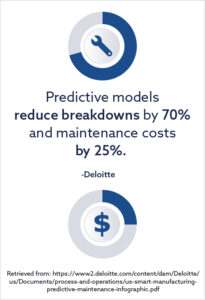 AI vs. Process Automation
AI vs. Process Automation Decision Intelligence
Decision Intelligence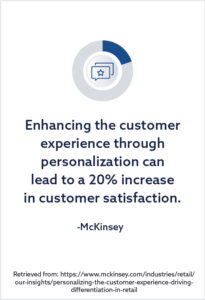
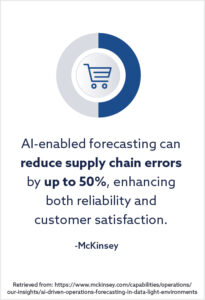 AI in Supply Chain & Operations
AI in Supply Chain & Operations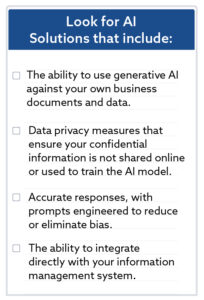 Data Privacy and Compliance
Data Privacy and Compliance
 Document Summarization: Making Long Content Digestible
Document Summarization: Making Long Content Digestible